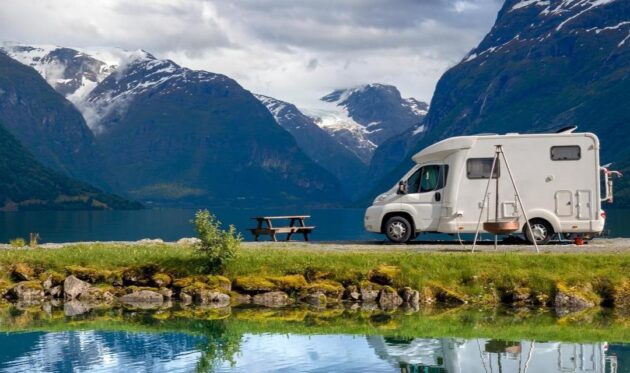Life on the road can bring freedom and peace. With a well-prepared RV, you can travel without giving up your daily comforts. Whether you stay near the coast, head into the mountains, or follow quiet highways through farmland, your RV becomes more than transport. It becomes your home. That means your setup should work for long days, changing weather, and places that shift from town to wilderness in a single hour. When planning your layout, it helps to think not only about where you will go, but also about how you will live once you get there. Tools like shade awnings from Carefree of Colorado can help create outdoor living space that feels as stable as your indoor space.

Table of Contents
Building a Livable Interior
Your RV interior sets the tone for your travel rhythm. Storage should stay simple and easy to reach. Heavy drawers and deep cabinets can make daily use feel difficult. Baskets, bins, and soft containers often store gear more smoothly than hard boxes. Soft goods like clothing, towels, and bedding store best when rolled or packed into flexible spaces.
Surfaces should be easy to clean. Smooth counters, vinyl floors, and washable fabrics help keep dirt and moisture from building up. Whether you cook daily or eat pre-made meals, a stable surface and good lighting help the space stay usable.
Sleep is part of comfort. Use a mattress topper if the built-in bed feels too firm or too soft. Clean linens and breathable sheets improve sleep quality. Blackout curtains and window covers also help block light in busy or urban campgrounds.
Creating Reliable Power and Light
Light and power give you the option to work, cook, and relax at any time of day. Your battery setup should match your habits. Solar panels support travel away from campsites, while shore power helps with full hookups. Many travelers carry both options.
Use warm LED lights inside to create a calm space. Headlamps and lanterns make outdoor time easier without drawing power from your RV. A simple string light hung under your awning can also light your cooking or sitting area outside.
Keep extra charging cables, a power bank, and an inverter if you plan to charge gear like laptops or cameras. With good planning, your power system can run clean and quiet while keeping all your devices working.
Setting Up Your Outdoor Space
Comfort expands when you use the space around your RV. A clean and shaded area outside helps you cook, eat, and rest without staying cooped up inside. A good awning blocks sun and light rain. Shade cloth or wind panels can attach to create more shelter.
Ground mats protect your feet and help you track less dirt inside. Simple outdoor chairs fold easily and store in small spaces. A small table gives you a place to eat or work. If you travel in dry areas, shade becomes more important. If you camp in wet places, shelter from rain helps more.
Many RV travelers treat their outside space as a porch or deck. With care, that space gives your home room to breathe.
Managing Water and Waste
Fresh water supports your daily comfort. Keep your water hose clean and stored in a sealed bin. A water pressure regulator protects your pipes at campgrounds. A water filter helps if you fill your tank from unknown sources.
Waste tanks require clear routines. Use treatment pods or liquid to help break down solids and reduce odor. Empty black and gray tanks before full to avoid clogs. Rinse with clean water after you empty the tanks. Gloves and hose fittings help make this task smoother and safer.
Always store hoses, fittings, and cleaning tools in a separate bin from drinking water tools.
Keeping Food Safe and Simple
Food storage makes or breaks long-term travel. Use clear containers to help you find food fast. Dry goods like rice, beans, oats, and pasta store well and cook with little effort. Stackable bins or soft-sided coolers give you access to items in small fridges.
Cookware should stay light and multi-use. A pan that works on a stove and a fire saves space. A cutting board that also serves as a tray or table adds function. Choose tools that clean easily with little water.
Eating outside reduces heat and steam inside your RV. Many people keep a simple grill or stove in their storage bin for use at campsites.
Preparing for Changing Weather
Weather shifts often on the road. Your comfort depends on how well you adjust to changes in heat, wind, or rain. Keep extra layers packed in small bags so you can add or remove clothes fast. Wet gear should hang outside or in a sealed space to dry.
Ventilation helps with heat and moisture. Roof fans and screen doors allow airflow without letting bugs in. Awnings and outdoor shades reduce indoor heat and offer cool rest areas.
If you camp in cold areas, insulating window covers and wool blankets help you sleep warmer without running heaters all night.
Moving Without Stress
Comfort also comes from how you move. Items that slide, fall, or shift make each trip harder. Use straps, blocks, and bins that hold gear in place while driving. Secure appliances and drawers. Keep heavy items low and soft goods up high.
Before you leave a campsite, check your gear. Pull in the awning, empty trash, and close vents and hatches. A short checklist helps you leave no tools behind and protects your RV on the move.
Conclusion
Traveling in an RV lets you carry your home wherever you go. But comfort does not come from space alone. It comes from how you use that space. With the right mix of tools, routines, and gear, you can sleep better, cook easier, and relax more deeply. Life on the road works best when your setup supports both rest and movement. A well-organized RV lets you stay present, move freely, and enjoy the world around you with fewer limits.
